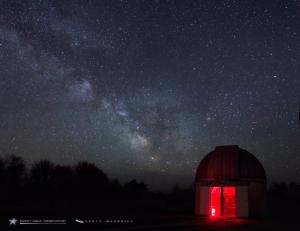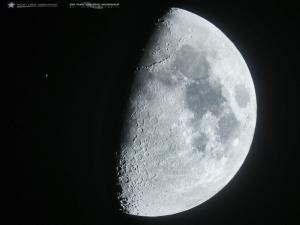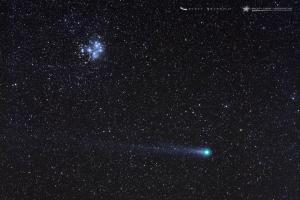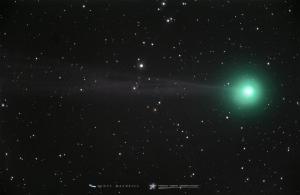
Stargazing Night
- Where:
- Frosty Drew Observatory
- When:
- Friday December 4, 2015 at 6:00 p.m.
- Cost:
- $1 Suggested Donation per Person
Tonight is Stargazing Night at Frosty Drew Observatory and the forecast looks awesome! We can expect clear skies, light wind, low humidity and fabulous views of the cosmos. The 29% waning gibbous Moon will sneak over the Eastern horizon at 1:15 a.m. offering up stunning views of the bright crescent. Before moonrise, the skies will be strikingly dark and full of stars. Surely not a night to miss!
We will open the Observatory and Sky Theatre at 6:00 p.m. In the Observatory, telescopes will showcase all the amazing sights only visible on super dark, moonless nights. Our target list is loaded with bouts of awesome, including Albireo, the Hercules Cluster, the Ring Nebula, the Orion Nebula, the Sculptor Galaxy, the M37 Open Cluster, and dozens of binary stars, nebulae, and star clusters. We will also grab our first look at Jupiter for the 2016 viewing season! Once the crescent Moon rises, we will direct our telescope towards the cratered lunar surface. In the Sky Theatre temps will be warm with astro-geek ambience in full effect. We will stay late tonight, possibly until pre-dawn making an attempt for an early first look at Comet C/2013 US10 Catalina, this year's Xmas comet.
Overall, tonight looks totally like the night to be out at Frosty Drew! The forecast is calling for amazing things and so many awesome celestial objects are out, just waiting for geeky freak-out moments. Super dark skies, stunning view of the Orion Nebula, first look at Jupiter, super sexy crescent Moon in the a.m. are all reasons to make tonight the night you let out that inner geek and make your own discovery of the cosmos at Frosty Drew Observatory!
-------------------------------------------------------------------------
Weekly Happenings
Scott MacNeill
On Monday, December 7th a stunning daytime celestial event will occur when the Moon visibly overtakes Venus in the afternoon daytime sky. This event is called an occultation and it is the last planetary occultation of 2015.
Lunar occultations occur when the Moon passes in between our view of a planet or star. This happens because the Moon, which orbits Earth every 27.3 days, visibly moves across the sky at a slower rate than the stars. Stars appear to move 15° per hour from the East to the West due to Earth's axial rotation, this is called “sidereal time”. Though the Moon only moves 14.45° per hour across the sky from East to West. This slight difference will cause the Moon's position to change about .55° per hour from the West to the East as it relates to background stars and planets. Since the Moon is inclined 5° from the ecliptic (the path the Sun takes across the sky), the Moon can visibly pass in between Earth and planets depending on your viewing location. When this happens, we can observe the Moon overtake the planet at a rate of about .55° per hour. Since the Moon covers an area of sky about .5° in diameter, the occultation will last about an hour.
Starting at 12:45 p.m. EST on December 7th, Venus will begin to pass behind the Northwest edge of the Moon. Once fully occulted, Venus will no longer be visible to the observer. At 1:44 p.m., Venus will emerge from behind the East edge of the Moon. On the day of the occultation, the Moon will sport a 14% waning crescent phase and Venus will show off a 69% waxing gibbous phase.
Viewing the occultation will be a slight challenge for us in New England. First, the occultation is happening during the daytime hours, so the Moon and Venus will not appear as bright as they do in twilight. Secondly, the occultation will occur just before moonset, so a low westerly view will be required. At 12:45 p.m. Venus will be about 15° above the Western horizon. When Venus re-appears, it will only be about 4° above the Western horizon. Though binoculars or a telescope will make for excellent viewing, the occultation will be naked eye visible.
Occultations happen rather regularly, though they usually involve the Moon and a dim star. Being that Venus is the third brightest object in the sky (the Moon is the second brightest), this occultation is certainly an event to catch. To view the entire occultation in New England, you will need to find a spot with an excellent view of the Western horizon. Clear skies will also be required. If you snap a photo or video of the occultation, be sure to post it on our Facebook page and we will share it on our time line. So mark your calendar and get out for the last occultation of 2015!
Remember that awesome comet that brought beautiful views to our holiday and winter time skies last year? That was Comet Lovejoy and the views were spectacular. At Frosty Drew Observatory we had naked eye sightings of the comet starting December 26th and continuing well into the New Year. Certainly a celestial Xmas present for all. Well it appears the cosmos has another celestial present in store for us this year as Comet C/2013 US10 Catalina makes its way into our early morning skies.
Comet Catalina was discovered on October 31, 2013 by the Catalina Sky Survey. It is an Ort Cloud comet that was likely nudged into the Solar System by tidal influences of other stars in our little corner of the galaxy. Catalina reached perihelion (its closest to the Sun) on November 15, 2015 and has been making its way out of the Solar System since. Before this solar encounter, Catalina may have had an orbital period of millions of years, though its current trajectory, altered by the encounter with the Sun, will result in its ejection from the Solar System.
As the comet moves away from the Sun it will rise higher and higher in our night time skies. Currently visible in the pre-dawn morning sky, Catalina is at binocular visibility. As we dive into the holiday season and the New Year, the comet may become naked eye visible under super dark skies. Additionally, we will have earlier views every night consecutively, putting us in the darkest part of the night for awesome viewing opportunities.
At Frosty Drew Observatory, we will make Comet Catalina a regular target for observation as we winter moves in. Be sure to frequently check out our Facebook and Twitter (@FrostyDrewOBSY) for viewing updates and any photographs we may catch of the comet. So make it a priority to get out in the early morning winter skies this December and catch a view of this year's Xmas comet!
-Scott



